Table of Contents
DIGESTIVE SYSTEM
The digestive system consists of organs like mouth, tongue, stomach, intestine, liver and salivary glands, which helps in obtaining energy from the food we consume in our daily life. Digestion helps us to get energy vitamins protein and necessary minerals. The food we consume cannot be utilized as it is by our body. It can easily absorbed by the body. This task is done by the digestive system.
Nutrition – The process by which living organism obtain and use food is known as nutrition. The human depends upon the plant for their food and energy, that is why they are caked as heterotrophs.
| Types of Nutrition | |
| Heterotrophic | Autotrophic |
| This organism gets their food from another Organism (plant or animal). | In this the organism produce their own food by itself by the process of Photosynthesis. |
| Ex- humans, animals | Ex-plant makes their own food by |
The Process of Nutrition in Human beings
- Ingestion- in this first stage food is taken in through the mouth.
- Digestion- in the next stage the conversion of complex food (taken in through the mouth) into a simple form occurs by the action of enzymes.
- Absorption- in this stage of the digestion, the digested food is absorbed into the blood stream.
- Assimilation- in this stage the absorbed food material is utilize by the body to provide energy or for growth and repair of tissue. Apart of the absorbed food is also stored for future use.
- Egestion- In the last stage of nutrition the undigested insoluble part of food is eliminated form of feaces.
Also Read: Nutrition in Living Organism
Digestive System in Human
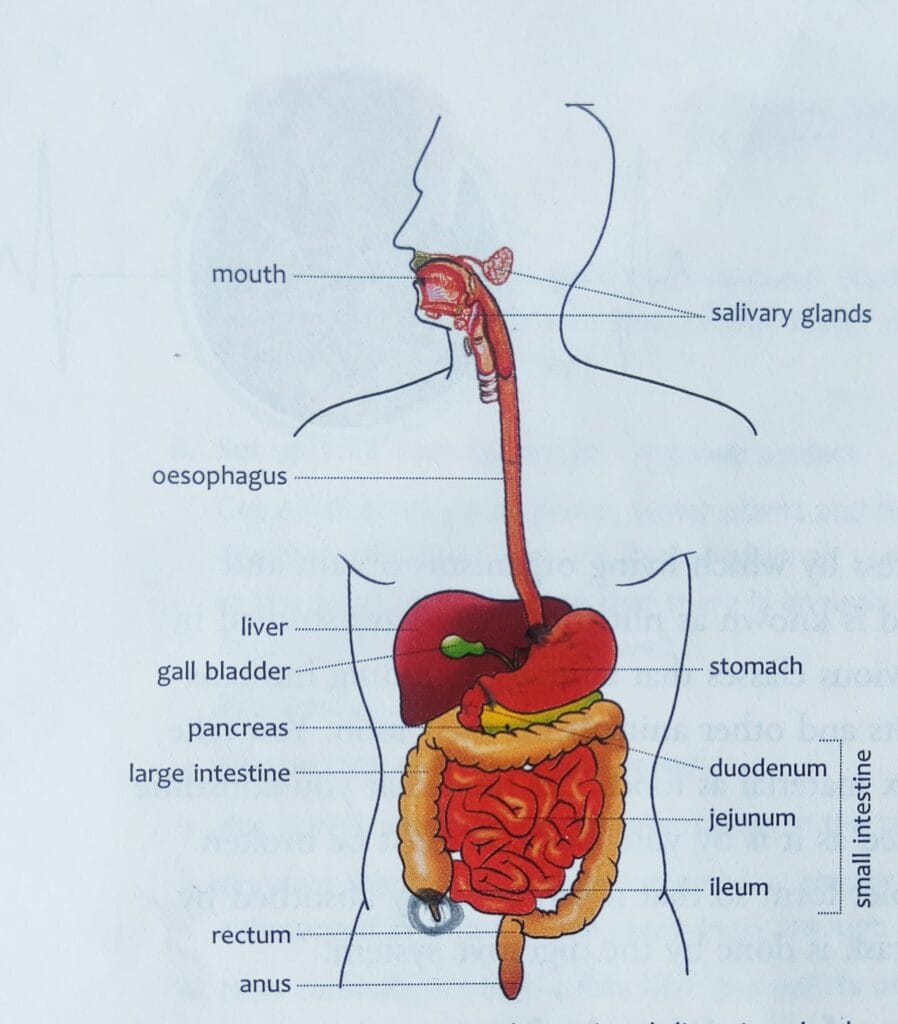
The digestive system in our body perform all the function related to the process of ingesting the food ,its digestion absorption , assimilation and egestion. The digestive system in humans consist of two parts. The alimentary canal and its associated glands.
The process of digestion involves the alimentary canal and its many accessory glands and organ system. The process of digestion is quite simple because of the presence of Monogastric system. Monogastric system means humans have only one chambered stomach unlike some animals as cows and buffalos which have four chambered Stomach.
Latest Update: UPCNET 2025 examination
The human digestive system also controlled and regulated by nervous and circulatory system, with the help of enzymes nerves blood and other organs of the digestive system fulfil the task of digestion.
Above paragraphs give a brief introduction of digestive system. In this article we will discuss in detail about the human digestive system.
Structure of Human Digestive System
The figure given here shows the different parts of the human digestive system,
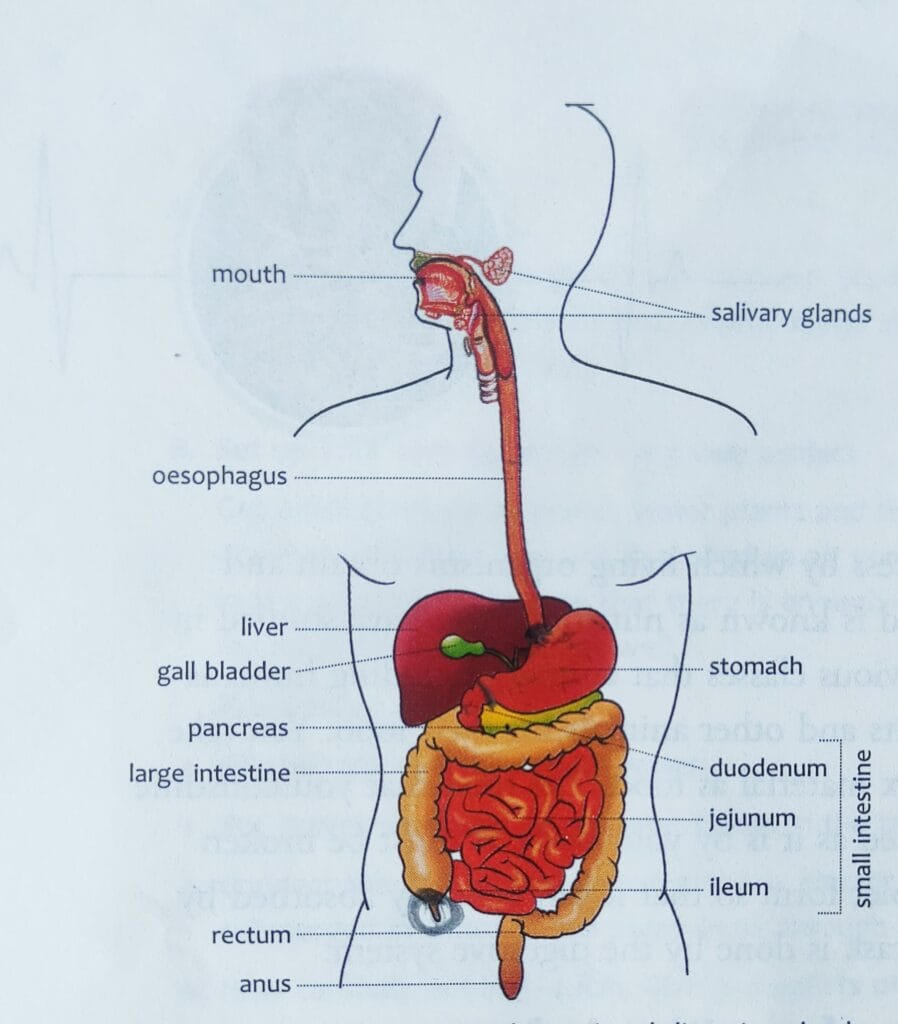
Parts of the Human Digestive System
The human digestive system consists of a group of organs which work together and convert complex food into essential nutrients and energy required for our body. Let us discuss the parts of digestive system one by one.
- Alimentary canal: It is along tube like muscular structure that runs from the mouth to the anus. It consists of organs like mouth pharynx, stomach, intestine rectum and anus.
- The food we eat passes through the alimentary canal and get digested gradually.
- The accessory glands: The glands which help in the digestion process but not the exact the part of alimentary canal. They stimulate the process of digestion by the enzymes which they release.
THE ALIMENTARY CANAL
The mouth- The alimentary canal start from mouth food is ingested through the mouth which opens in to a small chamber called mouth cavity or buccal cavity. The main function of mouth is to receive food and start digestion. Buccal cavity comprises of teeth, tongue and salivary glands.
ABVMU application form official site
Teeth –Teeth are the very important organ of Digestive System which help in digestion by cutting the food into small particle. The teeth play an Important role in mechanical digestion. Humans have two sets of teeth in their life the first set of teeth called as milk teeth normally appears between six or seven months of age. the milk teeth are also called as temporary or deciduous teeth. these are 20 in number and fall of between 6 and 12 year of age they are replaced with a new set of teeth, which remains for the rest of life therefore they are called permanent teeth.
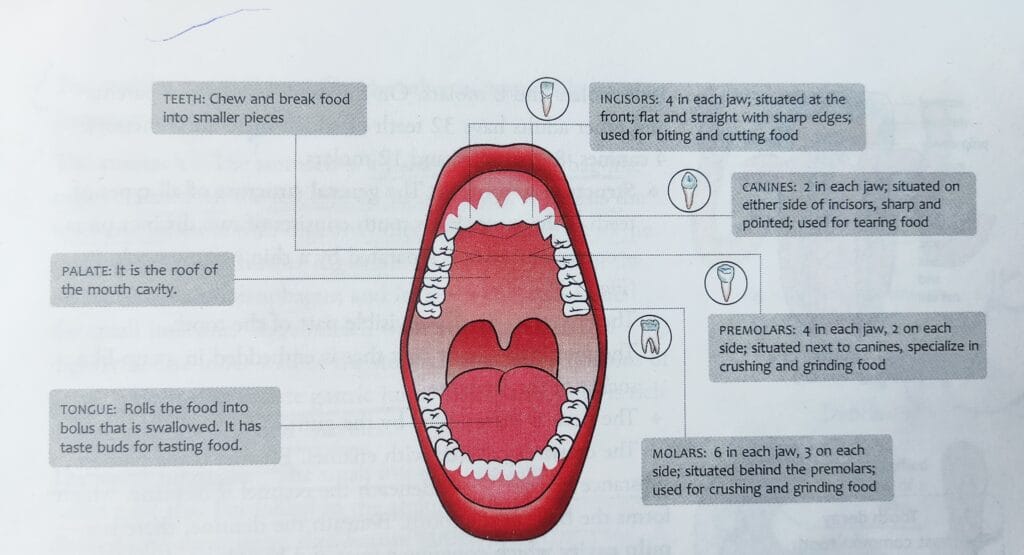
Also read: Tooth Decay
If you observe your teeth closely, you will find that not all of them are of the same shape and size. Some are broad others are narrow; some are sharp, other are flat.
Humans have four types pf teeth –
- Incisors
- Canines
- Premolar
- Molars
| Types of Teeth in adult Human beings | |||
| Type of Tooth | Function | No. In Each Jaw | Total in both Jaw |
| INCISORS | Biting/ Cutting | 4 | 4*2= 8 |
| CANINES | Tearing | 2 | 2*2= 4 |
| PREMOLARS | Crushing/ Grinding | 4 | 4*2= 8 |
| MOLARS | Crushing/ Grinding | 6 | 6*2= 12 |
As a small child you had 20 temporary teeth -8 incisor ,4 canines and 8 premolar. the molars only appear as permanent teeth later in life.
If you count your teeth now you will find that there are about 28 teeth- 8 incisor ,4 canines and 8 premolar and molar on the other hand your parent and other adults have 32 teeth.
The tongue- the tongue cavity also contains a thick muscular organ called the tongue. The tongue is covered with a mucus membrane, which keeps it moist all the time, it has taste buds that helps in distinguishing tastes. It also helps in moving the Food in the mouth. The tongue connected to the floor of mouth with the help of membrane called as frenulum. The main functions of tongue are as follows:
- Mastication of food
- Helps in Speech
- Helps in swallowing food
- Helps to identify taste as it contains taste buds.
The pharynx- The mouth cavity leads into the pharynx The Digestive System and Respiratory systems cross each other in the pharynx. The pharynx is the common passage for food and air from the mouth and nose to the throat. It is a wide muscular tube divided into their parts upper, middle and lower, only air passes through the upper part whereas both air and food pass through the middle part and only food passes through the lower part.

The Oesophagus (gullet)- The pharynx leads to the Oesophagus (also called the food pipe). The Oesophagus is a tube-like structure about 25 cm long, extending from the pharynx to the stomach. Food passes from the pharynx into the Oesophagus from where it moves forward by a series of muscular contractions and not by gravitational force. The muscles contract one after the other in a wave-like motion known as peristalsis.
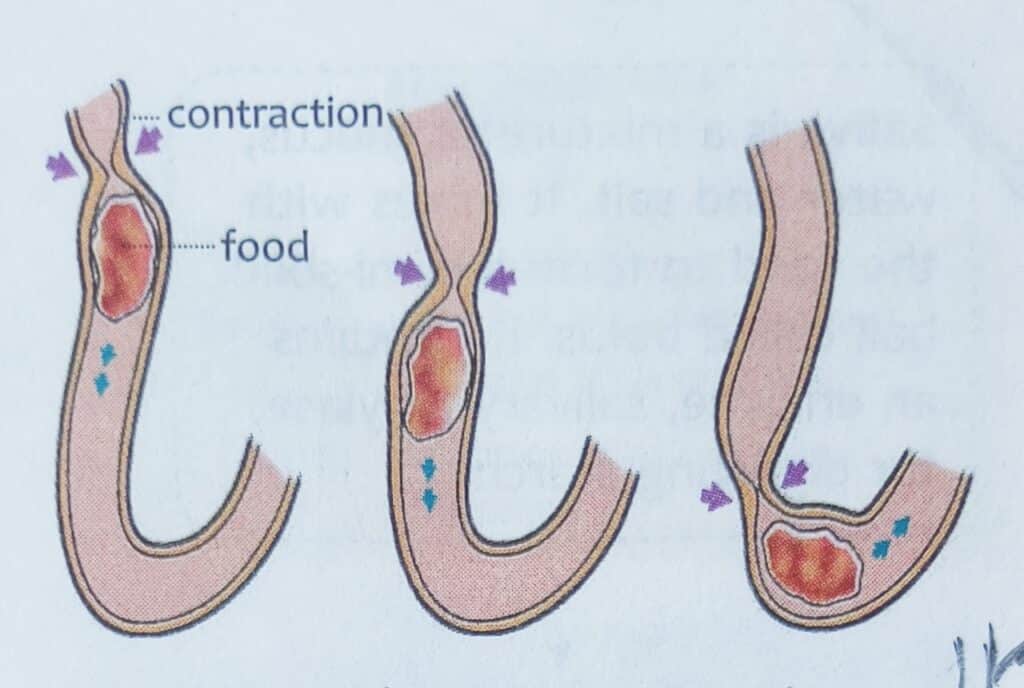
The stomach –The stomach is a J shaped muscular bag-like organ situated on the left side of the abdomen. It churns the food and mixes it with digestive juices and passes it on to the small intestine for further digestion. At the upper end of the stomach, lies the oesophagus; and its lower end opens into the small intestine. The stomach walls help in mechanical digestion. The inner wall of the stomach is lined by millions of gastric glands that secrete gastric juice This gastric juice is rich in hydrochloric acid and enzymes.
The small intestine -The small intestine is a long, coiled tube that lies folded in the abdomen. It is divided into three parts: duodenum (anterior part), Jejunum (middle part) and ileum (posterior part). The inner wall of the small intestine has billions of finger like projections called villi (singular: villus) The villi increase the surface area for the absorption of digested food.
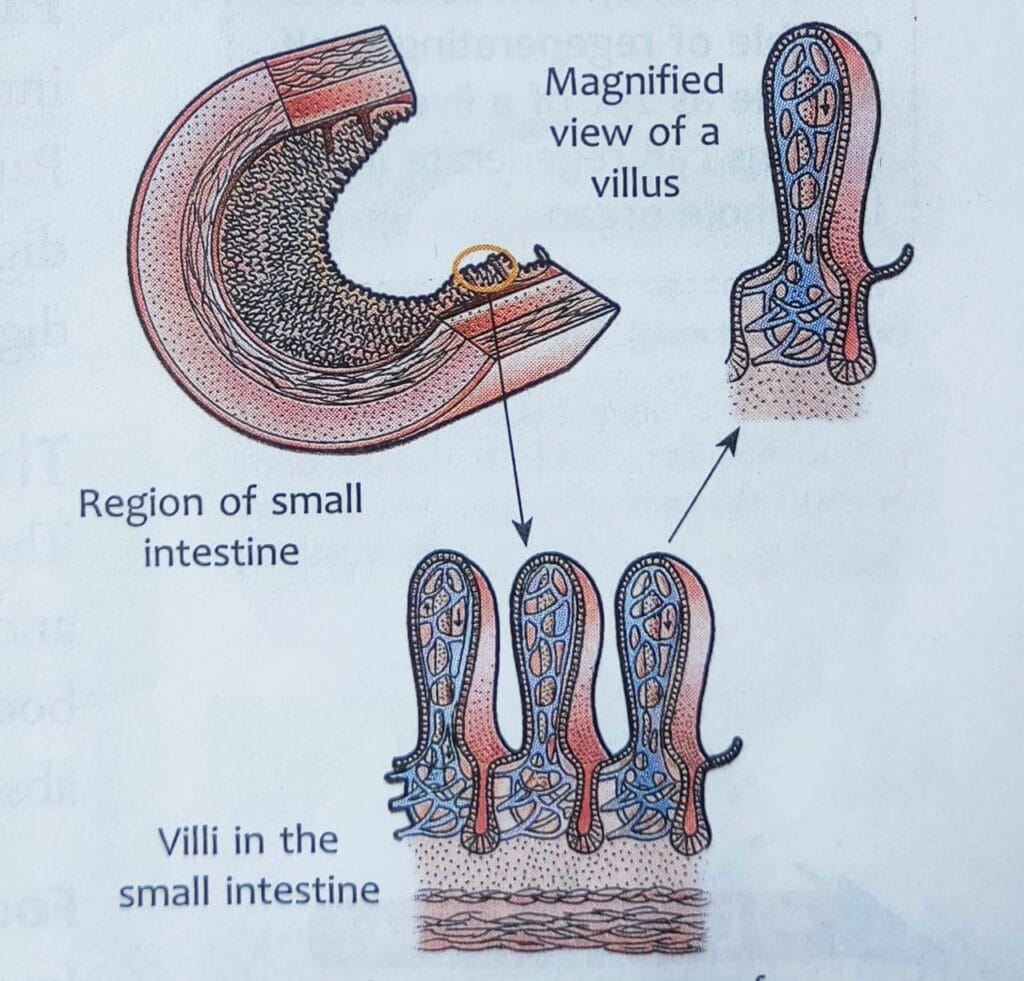
The large intestine, rectum and anus. The small intestine leads in the large intestine, which has a wider diameter bar as shorter in length. It has three parts: caecum, colon and rectum. Rectum is a short tube that opens to the outside through the anus.
ASSOCIATED GLANDS
The Digestive System of human has following glands-
Salivary gland – There are three main pairs of Salivary glands that open into the mouth cavity. These glands secret saliva a liquid that helps in moistening the ingested food and in the digestion of carbohydrate. The saliva also acts as solvent and destroy germs.
Liver-Liver is the largest gland inside our body it is located in the upper right side of the abdominal cavity is associated with the small intestine. Liver secrets bile: a greenish-yellow fluid that helps in breaking down large globules of fats into smaller droplets for chemical digestion. The liver also helps in regulating the blood sugar level and in controlling the transport and storage of carbohydrates.
Pancreas -Pancreas is another gland associated with the small intestine, it secretes pancreatic juice, which helps in digestion. Pancreatic juice contains many enzymes such as the sand digesting amylase, the protein-digesting trypsin and the fat digesting lipase.
The process of digestion
The digestive organs chemically act upon the food you eat and convert it into molecules that can be absorbed by your body. The process of converting complex food in to simple absorbable form is called digestion.
Food in the mouth
In the mouth the food is chewed by the teeth, while the food is being chewed it is softened by the saliva secreted by the salivary glands, Saliva contains an enzyme called salivary amylase or ptyalin, which acts on starch a carbohydrate and breaks it into maltose Starch (salivary amylase)→ Maltose
The softened, slightly digested food becomes a semi-solid ball called bolus which is swallowed.
Food on the pharynx and the oesophagus
The food is swallowed into the pharynx and then passes through the oesophagus. The muscles of the oesophagus push the food towards the stomach, No digestion takes place in the pharynx and the oesophagus .
Food in Stomach
The muscles of the stomach wall contract rhythmically, crushing and mixing the food with gastric juice, Gastric juice kills bacteria and helps in the digestion of proteins, It contains two enzymes – pepsin and renin .
Pepsin– Pepsin changes large protein molecules into smaller protein molecules called proteoses and peptones.
protein (pepsin) →proteoses and peptones
Rennin– Rennin changes the milk protein called casein into Paracasein, which is an insoluble curd.
Casein ( rennin) → Paracasein
The food moves out of the stomach into the intestine in the form of a thick paste called chyme.
| Different Enzymes and their Functions | ||
| Part | Enzyme | Functions |
| MOUTH | Salivary Amylase | Changes starch in to maltose |
| STOMACH | Pepsin | Changes Proteins into Proteoses and Peptones |
| Rennin | Changes casein into paracasein (insoluble curd) | |
| LIVER | Bile Juice (No Enzyme) | Emulsification of fat |
| PANCREAS | Lipase | Changes fats into fatty acids and Glycerol |
| Trypsin | Changes Proteins, proteoses, and peptones in to polypeptides | |
| SMALL INTESTINE | Erepsin | Changes Peptones and peptides into amino acids |
| Maltase | Changes maltose into Glucose | |
| Sucrase | Changes Sucrose into glucose and Fructose | |
| Lactase | Changes lactose into glucose and galactose | |
FOOD IN SMALL INTESTINE
Further digestion of the food (chyme) takes place in the upper part of the -small intestine. Small intestine is the largest part of the alimentary canal. it is about 6.5 metres long coiled tube. Bile from the gall bladder and pancreatic juice from the pancreas are received here.
Bile -Bile is made in the liver and stored in the gall bladder. Although it does not contain any enzyme. bile helps in digestion by breaking down the fats into tiny droplets for the enzymes to act upon. It also provides an alkaline medium for the action of the enzymes in pancreatic juice, trypsin and lipase.
Trypsin acts on proteins, proteoses and peptones and changes them into polypeptides.
Proteins, proteoses and peptones(trypsin) → polypeptides
These are further broken down into amino acids smaller units of proteins).
Lipase acts on fats to change there into fatty acids and glycerol.
Fat ( lipase ) → fatty acid and glyceride
Sugar (carbohydrates) are also digested in the small intestine as follows:
Maltase changes maltose into glucose.
Sucrase changes sucrose into glucose and fructose, and lactase changes lactose into glucose and galactose.
Sucrose (sucrase) → glucose and fructose
Lactose ( lactase ) → glucose and galactose
The small intestine not only digests the food absorbs it. The villi in the small intestine contains blood capillaries. The digested food passes through the thin walls of these blood capillaries and enters the blood stream. This is called absorption.
FOOD IN LARGE INTESTINE
Some food cannot be digested and is therefore not absorbed in the blood. This food moves down to the large intestine where the excess water in it is reabsorbed. The undigested food forms faeces, which moves to the rectum and is passed out at regular intervals through the anus. This is called egestion.
Absorption
After digestion, the molecules of food that we eat converted in its smallest particles. These particles can pass through the walls of the small intestine and diffused into our blood, This is called Absorption.
The main absorption of food takes in to the small intestine but some absorption occurs in other parts of Alimentary canal as mouth and large intestine. The small intestine has the special adaptation as Villi and Microvilli. These adaptations help in the faster absorption of food.
Assimilation
All the absorbed nutrients are not used up, immediately by the body. So, they are changed into various forms that can be stored until they are needed. This is called assimilation.
- Glucose is converted into glycogen and stored in the liver. When required by the body, the liver converts glycogen into glucose.
- Excess of glucose is also converted into fat and stored in the adipose tissues. Fatty acids either provide energy or are stored under the skin as fat.
- Amino acids are used for the synthesis of proteins. Excess amino acids are converted into urea which is removed from the blood by the kidneys in the form of urine.
Disorders of Digestive System
Digestive System of human got infections from parasites of intestine like tapeworm, roundworm, threadworm, etc.
Indigestion
Indigestion
You may have sometimes experienced pain or burning in the upper part of your stomach. Or, else you may felt discomfort due to the stomach being too full. The cause of both conditions could be indigestion.
Common symptoms of indigestion:
- Abdominal pain, heart burn
- Bloating (feeling of a full stomach)
- Excessive gas
- Nausea or vomiting
- Burning sensation in the stomach
Causes of indigestion:
- Eating very spicy or oily food
- Lying down soon after meals
- Overeating
- Drinking too much water between meals
Drinking alcohol and sometimes cold drinks with meals Indigestion can be prevented by maintaining healthy eating habits, eating smaller but regular meals, eating properly cooked food and avoiding fried and oily foods.

Pingback: KGMU Recruitment 2024 Non Teaching Posts Notification Released For 330+ Posts How to Apply Online - DHANUSHA
Pingback: What is MBBS Course? How to Become a Doctor in India in 2025: Complete Information - DHANUSHA
Pingback: Class 10 Nutrition: Detailed Overview 2025 - DHANUSHA